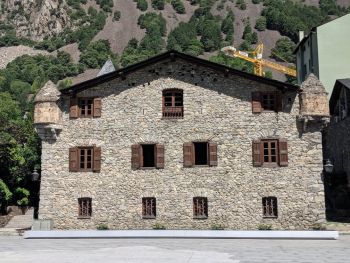Council of Regions of Anserisa (Pacifica): Difference between revisions
>Anserisa No edit summary |
>Anserisa No edit summary |
||
| Line 2: | Line 2: | ||
| government_name = Council of Regions | | government_name = Council of Regions | ||
| nativename = ''Concilio dem Regionalem'' | | nativename = ''Concilio dem Regionalem'' | ||
| image = [[File:Seal of the Council.svg|center| | | image = [[File:Seal of the Council.svg|center|220px]] | ||
| alt = Seating of the Council | | alt = Seating of the Council | ||
| date_established = 7th September 1450 (570 years ago) | | date_established = 7th September 1450 (570 years ago) | ||
Revision as of 03:25, 31 March 2020
| Council of Regions | |
|---|---|
| Concilio dem Regionalem | |
| Overview | |
| Established | 7th September 1450 (570 years ago) |
| Country | Republic of Anserisa |
| Leader | Principal Councillor of Anserisa |
| Headquarters | Council of Envoys Building, Brantavilla, Anserisa |
| Seating | |
The Council of Regions (Anserisan: Concilio dem Regionalem) is the part of the legislative branch of the Republic of Anserisa. It is led by the Principal Councillor and it is part of the Congress of the Republic as the upper house. It is the oldest form of lawmaking in Anserisa, with its roots dating from the Council of Envoys.
The Council is responsible for the approval of the bills adopted by the National Convention and to approve the nominations made by the President of Anserisa, mainly the nominations made on the Republican Commission like the Vice-President and the Commissioners and all the judiciary, mostly the members of the Supreme Court of Justice.
Members
The Council is composed of 15 Councillors elected for mandates of 6 years. There are 5 Councillors for each of the three islands of Anserisa. The Councillors are elected by a regional proportional voting system.
Partition of the Council
| Island | Socialist | Republican | Conservative |
|---|---|---|---|
| Branta | 3 | 1 | 1 |
| Haliétusa | 2 | 2 | 1 |
| Rubecula | 3 | 1 | 1 |
Principal Councillor
According to the Constitution[1], the Principal Councillor is responsible for the agenda of the Council and can assemble into a caucus of members to establish the agenda. Normally, the Principal Councillor will consult with the General Representative to establish the common agenda of the two houses of Congress but when the two are members of opposing parties such collaboration is not necessarily followed.
Speaker of the Council
The Speaker of the Council is responsible for the application of the rules of the Council. It is also the de facto Acting-President of the Congress, along with the Deputy-President of the Congress, the Chair of the National Convention
Counter Councillor
The Constitution provides for a Councillor to become the Counter Councillor with powers to establish a caucus of members and to submit motions of censures against the caucus of the Principal Councillor.
Powers and functions
The Council has powers over the approval of the bills adopted by the National Convention. It can adopt amendments to bills and send the bill back to the Convention for a second reading. A bill needs the approval of the Council before being sent to the President for the proclamation into law. The Council also has powers over the nominations made by the President and can reject a nomination made by the President.
De facto all the Councillors are also members of the Congress of the Republic and thus can also execute those powers.
Council of Envoys Building

The sittings of the Council happen in the same building that was housing the Council of Envoys meetings since the Treaty of Envoys in 1387.
See also
- ↑ Constitution of Anserisa (1815). Office of the Legislative Documents of Anserisa, Brantavilla.